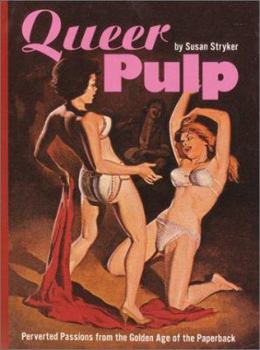Queer Pulp: Perverted Passions from the Golden Age of the Paperback
From homicidal homos to locked-up lesbians, and almost every sexually dangerous combination in between, Queer Pulp: Perverted Passions from the Golden Age of the Paperback is the first complete expose... This description may be from another edition of this product.
Format:Paperback
Language:English
ISBN:0811830209
ISBN13:9780811830201
Release Date:September 2001
Publisher:Chronicle Books
Length:96 Pages
Weight:1.05 lbs.
Dimensions:1.0" x 1.0" x 1.0"
Customer Reviews
3 ratings
Time Will Tell
Published by Thriftbooks.com User , 18 years ago
Taking a similar tact to Michael Bronski's epochal PULP FRICTION, ace historian Stryker parlays a collection of battered pulps into a periscope through the murky waters of gay and lesbian acceptance in the 1940s, 1950s, and 1960s. She's able to show, just through the cover alone, how bisexuality proved to be the wedge that eventually toppled Amewrica's binary notions of sexuality. Triangle books, two men and a woman, two women and a man, perhaps seemed safer for timid 50s readers to understand, or at any rate aroused mass curiosity, and before you know it, the "divided path" had made way for full on "queer passions." Stryker devotes separate chapters to the paperback revolution itself, as well as to lesbian, transgender, and gay male bodies of work. The covers are sometimes humorous, sometimes inane, but all of them give off a nervous sexual energy that still fills you up through your hands and eyes. She delves into the lives of the primary pulp creators, insofar as they have been divulged, and makes you feel with them as they created this enormous corpus. Chronicle Books has outdone itself with its huge, creamy graphics and must have had a good time doing so, with some amusing juxtapositions. What happened to the end, though? The book ends without so much as an adieu, nearly in the middle of a paragraph. Perhaps the book's chic designer overrode whatever conclusion tthe author had written; they had perhaps run out of illustrations and, like Alice in the Lewis Carroll book, saw no sense in a book that had neither "pictures nor conversations." Instead, an able bibliography appears, meekly enough, and a tidy 4 page index. Some of these authors are new to me, but I hope very soon to be able to pore through some of the books of Chris Davidson (GO DOWN, AARON; CAVES OF IRON; A DIFFERENT DRUM; THE GOLDEN TUFT), who sounds the most far-fetched of the lot. Will I be using one hand, or two, only time, or Tim, will tell.
Very Interesting!
Published by Thriftbooks.com User , 18 years ago
This is an easy read and very fascinating at the same time. Stryker accomplishes bridging the gap between the social atmosphere of the golden age and covering the different genres of books typically associated with "queer" (i.e. bisexuality, transexuality, and homosexuality) while giving a plethora of examples in each category. You just might find a pulp in this book you must read.
A fine coverage of paperback passions
Published by Thriftbooks.com User , 20 years ago
Susan Stryker has written a succinct account of this corner of American paperback publishing during the middle of the last century. The four areas she covers are lesbian, bisexual, transgender and gay with each chapter having the relevant book covers (150 in all) nicely placed so they are near the appropriate text. She covers the two sides of the pulp fiction market, the big mainstream publishers, who issued literature in a mass market format and so had to present Tennessee Williams, Gore Vidal, Somerset Maugham, Truman Capote, Radclyffe Hall, James Baldwin and others with suggestive images (the predictable shapely female with the half unbuttoned blouse) and come-on cover lines to generate sales, I bet they would have loved to change the titles to something more racy though. The other side was the very cheaply produced (but expensively priced) paperback that had no literary pretence and was produced for the 'one hand reader'. Plenty of these latter covers are shown and the designs are as predictable as the words inside but when you see them presented, sometimes four to a page, their overwhelming blandness becomes fascinating, however there are some that look as if a designer has been able to produce something creative with art and typography. So many of the lowbrow and no-brow paperbacks are parodies of the genre, 'Hot Pants Homo' by Percy Fenster, 'The Man They Called My Wife' by Stark Cole' or 'Take My Tool' by Vivian LeMans, all with the appropriate tacky graphics and blurbs. Overall an interesting book (and well designed, too) about a slice of pop culture publishing that sold copies in the millions. Another book, also well designed, covering the same subject is Jaye Zimet's 'Strange Sisters' (ISBN 0140284028) with two hundred covers of lesbian pulp fiction. Both books will be appreciated by graphic designers and pop culture fans.






